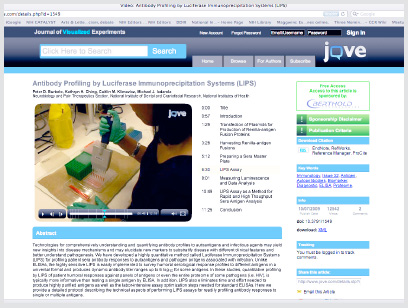New Methods
LIPS Service: New Assay Method May Revolutionize Antibody Testing
When Peter Burbelo contemplated a more efficient way to perform antibody assays, a light bulb lit up over his head—or perhaps it was luciferase, the enzyme behind the bioluminescence of fireflies.

Researchers can learn to profile antibodies using the LIPS technique by watching a video.
Burbelo, the staff scientist for NIDCR’s Neurobiology and Pain Therapeutics section, came to the NIH from Georgetown University (Washington, D.C.) in late 2006 with a working model of his assay technique, called luciferase immunoprecipitation systems, or LIPS. His section chief, Michael Iadarola, hoped to use the technology for humoral (antibody-mediated) immune reactions.
A few tweaks and some 40 peer-reviewed journal articles later, Burbelo and Iadarola have crafted what may become the assay of choice for detecting antibodies implicated in dozens of disorders as diverse as type 1 diabetes, Sjögren syndrome, and infectious diseases, for which detection sensitivity is crucial but has been lacking. Many of these studies are being conducted in collaboration with other NIH scientists.
Burbelo describes LIPS as a traditional bait-and-bind diagnostic assay, in which the bait—an antigen, or protein snippet known to elicit an antibody response—is fused to a luciferase enzyme. This bait then binds to the target antibody in serum or other bodily fluids and glows; the brighter the glow, the greater the amount of antibody caught.
The sensitivity of the LIPS technique is three or more orders of magnitude greater than the traditional technique, enzyme-linked immunosorbent assay (ELISA). One reason is that, with LIPS, antigens maintain more of their three-dimensional shape as they interact with antibodies because the assay is performed in solution rather than in formats in which the protein is adsorbed onto a two-dimensional surface or a membrane.
And with its relatively low cost and ease of use, LIPS is poised to become a universal format for the detection of antibody responses to almost any protein antigen.
Among Burbelo’s early successes was detecting antibodies in previously diagnosed patients with Sjögren syndrome, a chronic autoimmune disorder affecting the lacrimal and salivary glands. He found that nearly three-quarters of the patients had antibodies not detected by ELISA. Digging deeper, his NIDCR-based team found that 14 percent of the subjects with Sjögren syndrome had antibodies against a thyroid antigen, 16 percent had antibodies against an antigen associated with autoimmune gastritis, and 12 percent had antibodies to aquaporin-4. All the subjects who had anti-aquaporin-4 autoantibodies showed neurological symptoms including peripheral neuropathy.
This “suggested that autoantibodies against glial cell components might be biomarkers or play a role in peripheral neuropathy,” said Iadarola.
Burbelo has also worked on Lyme disease, river blindness, Kaposi sarcoma-associated virus, tuberculosis, and upward of 25 additional pathogens. In some cases, LIPS can be used to distinguish different conditions caused by a single infectious agent. LIPS can also be used to simultaneously detect antibodies against partial and whole proteomes, such as those from the human immunodeficiency virus and hepatitis C.
Burbelo and Iadarola recently finished a project with NIAID’s Steven Holland on people with thymic malignancies. They found that anti-cytokine autoantibodies may promote opportunistic infections.
Iadarola sees the LIPS assay as part of a comprehensive disease surveillance technology. He believes LIPS could be used in routine medical assessments throughout a patient’s lifetime as a means of obtaining highly informative and potentially predictive information on a wide spectrum of diseases, including cancer and neurological and degenerative diseases.
LIPS is now semiautomated with a 96-well format, enabling the Iadarola lab to run upward of a thousand samples in one day. The technique is depicted in a video titled “Antibody Profiling by Luciferase Immunoprecipitation Systems (LIPS)”. The video features Kathryn Ching, also a scientist in Iadarola’s lab and co-author on many papers.
The video describes everything you need to perform the LIPS assay in your lab, said an, uh, inundated Burbelo.
This page was last updated on Monday, May 2, 2022
